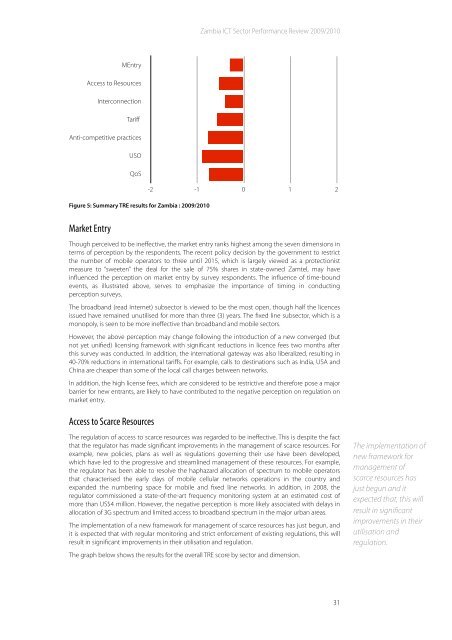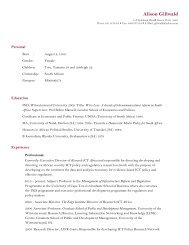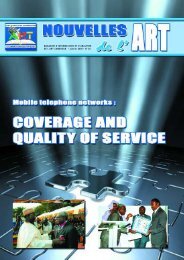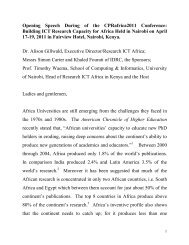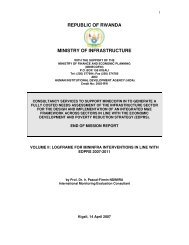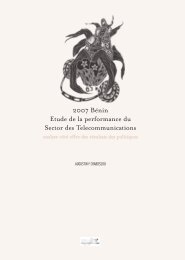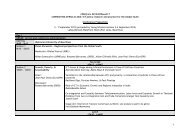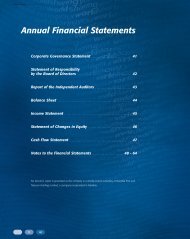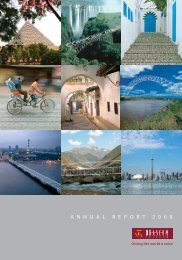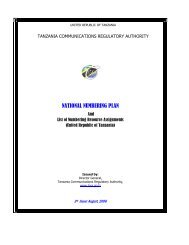Zambia ICT Sector Performance Review 2010 - Research ICT Africa
Zambia ICT Sector Performance Review 2010 - Research ICT Africa
Zambia ICT Sector Performance Review 2010 - Research ICT Africa
You also want an ePaper? Increase the reach of your titles
YUMPU automatically turns print PDFs into web optimized ePapers that Google loves.
<strong>Zambia</strong> <strong>ICT</strong> <strong>Sector</strong> <strong>Performance</strong> <strong>Review</strong> 2009/<strong>2010</strong><br />
MEntry<br />
Access to Resources<br />
Interconnection<br />
Tariff<br />
Anti-competitive practices<br />
USO<br />
QoS<br />
Figure 5: Summary TRE results for <strong>Zambia</strong> : 2009/<strong>2010</strong><br />
-2 -1 0 1 2<br />
Market Entry<br />
Though perceived to be ineffective, the market entry ranks highest among the seven dimensions in<br />
terms of perception by the respondents. The recent policy decision by the government to restrict<br />
the number of mobile operators to three until 2015, which is largely viewed as a protectionist<br />
measure to “sweeten” the deal for the sale of 75% shares in state-owned Zamtel, may have<br />
influenced the perception on market entry by survey respondents. The influence of time-bound<br />
events, as illustrated above, serves to emphasize the importance of timing in conducting<br />
perception surveys.<br />
The broadband (read Internet) subsector is viewed to be the most open, though half the licences<br />
issued have remained unutilised for more than three (3) years. The fixed line subsector, which is a<br />
monopoly, is seen to be more ineffective than broadband and mobile sectors.<br />
However, the above perception may change following the introduction of a new converged (but<br />
not yet unified) licensing framework with significant reductions in licence fees two months after<br />
this survey was conducted. In addition, the international gateway was also liberalized, resulting in<br />
40-70% reductions in international tariffs. For example, calls to destinations such as India, USA and<br />
China are cheaper than some of the local call charges between networks.<br />
In addition, the high license fees, which are considered to be restrictive and therefore pose a major<br />
barrier for new entrants, are likely to have contributed to the negative perception on regulation on<br />
market entry.<br />
Access to Scarce Resources<br />
The regulation of access to scarce resources was regarded to be ineffective. This is despite the fact<br />
that the regulator has made significant improvements in the management of scarce resources. For<br />
example, new policies, plans as well as regulations governing their use have been developed,<br />
which have led to the progressive and streamlined management of these resources. For example,<br />
the regulator has been able to resolve the haphazard allocation of spectrum to mobile operators<br />
that characterised the early days of mobile cellular networks operations in the country and<br />
expanded the numbering space for mobile and fixed line networks. In addition, in 2008, the<br />
regulator commissioned a state-of-the-art frequency monitoring system at an estimated cost of<br />
more than US$4 million. However, the negative perception is more likely associated with delays in<br />
allocation of 3G spectrum and limited access to broadband spectrum in the major urban areas.<br />
The implementation of a new framework for management of scarce resources has just begun, and<br />
it is expected that with regular monitoring and strict enforcement of existing regulations, this will<br />
result in significant improvements in their utilisation and regulation.<br />
The graph below shows the results for the overall TRE score by sector and dimension.<br />
The implementation of<br />
new framework for<br />
management of<br />
scarce resources has<br />
just begun and it<br />
expected that, this will<br />
result in significant<br />
improvements in their<br />
utilisation and<br />
regulation.<br />
31


